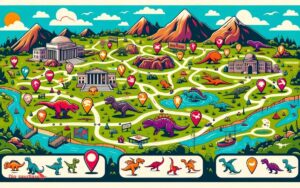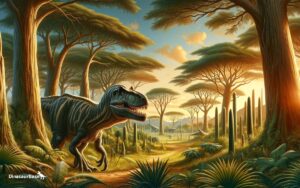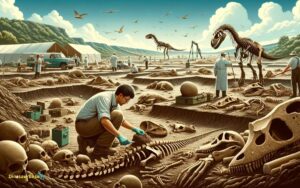What Dinosaurs Lived in Australia
In a land where vast deserts now stretch under blazing skies, ancient giants once roamed, their footprints etched into the very fabric of Australia's rich tapestry.
Among them, the mighty Australovenator, an apex predator, stalked the landscape, while the armored Minmi whispered tales of survival through its fossil remains.
These creatures, along with others like the colossal Diamantinasaurus and the peculiar Leaellynasaura, paint a picture of an era shrouded in mystery and intrigue.
As we embark on a journey to uncover the secrets of these ancient beings, one cannot help but wonder what other discoveries lie buried beneath the surface, waiting to tell their part of Australia's prehistoric saga.
Key Takeaways
- Australia was home to diverse dinosaurs, including theropods, armored, and herbivorous species.
- Unique adaptations such as Minmi's complex armor and Leaellynasaura's large eyes highlight evolutionary responses to their environments.
- The ecosystems ranged from semi-arid regions to polar conditions, supporting a variety of dinosaur life.
- Fossil discoveries continue to provide insights into the behavior, diet, and survival strategies of Australian dinosaurs.
The Mighty Australovenator
Among the fearsome predators that once roamed the ancient landscapes of Australia, the Australovenator stands out for its remarkable agility and formidable hunting capabilities. This theropod dinosaur, hailing from the Cretaceous Period, has been thoroughly analyzed through fossil records, offering insights into its physical attributes and ecological niche.
Its skeletal structure suggests a highly mobile predator, capable of swift movements to ambush prey. The Australovenator's forelimbs, equipped with sharp claws, were likely used to grasp and subdue its victims, indicating a level of predation sophistication.
Scientific examination of its teeth and jaw mechanics reveals adaptations for a carnivorous diet, showcasing the efficiency in its killing and feeding methods. This evidence collectively paints a picture of the Australovenator as a dominant predator in its ecosystem, adept at hunting and survival.
Minmi: An Armored Enigma
Minmi, an armored dinosaur from Australia, presents a unique study subject due to its distinctive protective plating. Recent analyses shed light on its habitat and dietary preferences, suggesting adaptations to a specific ecological niche.
The timeline of fossil discoveries of Minmi outlines a chronological framework for understanding its evolution and extinction patterns.
Minmi's Distinctive Armor
The distinctive armor of Minmi paravertebra sets it apart as a unique enigma in the realm of Cretaceous dinosaurs, showcasing an intricate arrangement of osteoderms that provided formidable protection. These bony plates, embedded in the skin, exhibit a complexity not uniformly seen across other ankylosaurians.
Key aspects of Minmi's armor include:
- Variability in Osteoderm Shape: Unlike the uniformly shaped osteoderms of its relatives, Minmi displays a range of shapes, suggesting a highly specialized form of defense.
- Strategic Placement: The armor isn't randomly distributed but appears to cover vital areas, offering targeted protection against predators.
- Potential for Thermoregulation: The arrangement might've facilitated heat dissipation, a feature that underscores the evolutionary adaptiveness of Minmi's armor.
This analysis underscores the significance of Minmi's armor in understanding its survival strategies in the Cretaceous period.
Habitat and Diet Insights
Having explored the intricacies of Minmi's armor, attention now turns to its habitat and diet, which further illuminate the dinosaur's ecological niche and survival mechanisms in the Cretaceous period.
Minmi, primarily found in what's now Australia, thrived in a diverse environment characterized by lush forests and vast floodplains. This habitat provided a rich source of vegetation, aligning with the dinosaur's herbivorous diet.
Scientific analyses suggest Minmi possessed a complex digestive system, capable of processing a variety of plant materials, ranging from ferns to conifers. This dietary flexibility not only highlights the adaptability of Minmi but also underscores the ecological richness of Cretaceous Australia, offering a window into the interactions between dinosaur species and their environments during this epoch.
Fossil Discoveries Timeline
Several pivotal fossil discoveries over the decades have pieced together the enigmatic history of Minmi, an armored dinosaur that roamed ancient Australia. This small yet fascinating dinosaur, belonging to the ankylosaur family, offers insight into the diversity of prehistoric life on the continent.
The timeline of Minmi's discovery is marked by significant finds:
- 1980: The initial discovery of Minmi fossils in Queensland introduces the scientific world to Australia's unique contribution to dinosaur paleontology.
- 1990s: Further excavations reveal more about Minmi's physical structure, including its distinct armored plates and possible defensive mechanisms.
- 2000s: Advanced imaging techniques provide unprecedented details of Minmi's skeletal structure, affirming its classification and shedding light on its evolutionary adaptations.
These discoveries underscore Minmi's role in understanding the evolutionary lineage of armored dinosaurs in Gondwana.
Diamantinasaurus: Australia's Titan
The Diamantinasaurus, a colossal titan from Australia's prehistoric era, demands attention for its impressive size and distinctive appearance.
Analyses of fossil evidence suggest this dinosaur navigated a lush habitat, relying on a diet that supported its massive frame.
Understanding its ecological role offers insights into the dynamics of Cretaceous-period ecosystems in Australia.
Size and Appearance
Diamantinasaurus, a colossal titan of ancient Australia, exhibited a remarkable size and appearance, characterized by its massive, elongated body and robust limbs. This sauropod's physique suggests it was well-adapted to support its considerable weight, which scientists estimate was in the range of tens of tonnes.
The distinct features of Diamantinasaurus can be summarized as follows:
- Vast Size: It was among the largest dinosaurs in Australia, with a length that could exceed 15 meters.
- Robust Limbs: Its limbs were exceptionally sturdy, designed to carry its massive bulk.
- Elongated Neck and Tail: The dinosaur possessed a long neck and tail, which were likely used to reach vegetation and maintain balance, respectively.
These physical attributes underscore Diamantinasaurus's status as a dominant herbivore in its ecosystem, showcasing the diverse and impressive range of dinosaurian life that once thrived in Australia.
Habitat and Diet
Understanding the massive size and robust structure of Diamantinasaurus leads us naturally to explore its habitat and diet, crucial elements that supported its existence in ancient Australia. This titanic sauropod inhabited the lush, riverine ecosystems of what's now Queensland, thriving in environments that were rich in vegetation.
Scientific analyses suggest that Diamantinasaurus's diet predominantly consisted of ferns, cycads, and conifers, plants that were abundant in its habitat and could provide the immense amount of energy required by such a large creature. Its long neck enabled it to reach high into the tree canopy, allowing it to access a wider variety of food sources.
This adaptability in feeding strategies likely played a key role in the survival and evolutionary success of Diamantinasaurus in the diverse ecosystems of ancient Australia.
The Peculiar Leaellynasaura
Among the diverse dinosaur fauna of ancient Australia, Leaellynasaura stands out for its unique adaptations to the polar conditions it once inhabited. This small, bipedal herbivore exhibited several distinct features, which allowed it to thrive in the harsh, variable climates of Cretaceous Australia, where seasonal darkness and cold prevailed for extended periods.
Key adaptations include:
- Large Eyes: Suggesting enhanced visual capabilities, possibly for navigating through low-light conditions.
- Long Tail: Likely provided balance and agility in dense forest underbrush or when escaping predators.
- Insulating Feathers: Speculated to keep it warm, supporting the hypothesis of endothermy in some dinosaurs.
Leaellynasaura's evolutionary responses to its environment highlight the complexity of dinosaur ecosystems and their ability to adapt to extreme climates, offering valuable insights into paleoecological dynamics.
Muttaburrasaurus: The Duck-Billed Giant
The Muttaburrasaurus, a distinguished herbivore, thrived in Australia's Late Cretaceous period, showcasing a unique combination of anatomical features that underscore its adaptation to diverse ecological niches.
Characterized by its large, duck-bill-like snout, this dinosaur is believed to have fed on a variety of plant matter, from tough, fibrous leaves to more tender shoots. Its robust limbs suggest a lifestyle that could accommodate both browsing and possibly foraging in shallow waters.
The presence of large nasal passages hints at a complex vocalization system, possibly used for communication within its species. This giant's fossils, primarily found in northeastern Australia, provide critical insights into the continent's prehistoric ecosystem and the evolutionary pathways that shaped the diversity of herbivorous dinosaurs during this era.
The Enigmatic Rapator
Shrouded in mystery, Rapator stands out as one of Australia's most enigmatic dinosaurs, with scant fossil evidence leaving its habits and full anatomical structure open to speculation. Discovered in the early 20th century, its classification has been a subject of debate among paleontologists. The limited fossils suggest a theropod lineage, yet definitive placement within this group remains elusive.
Key points to consider about Rapator include:
- Fossil Rarity: Only a single fossil, a large hand bone, has been confidently attributed to Rapator, limiting detailed analysis.
- Possible Theropod Affiliation: Morphological characteristics hint at a predatory lifestyle akin to other theropods.
- Uncertain Size and Diet: Without more comprehensive fossil records, estimates of its size and dietary habits are speculative, drawing from comparisons to related species.
Savannasaurus: Australia's Sauropod
Roaming the ancient landscapes of Australia, Savannasaurus emerges as a noteworthy sauropod, distinguished by its unique physical characteristics and ecological adaptations.
This herbivorous dinosaur, part of the Titanosauria group, lived during the Cretaceous period. Its discovery shed light on the diversity and distribution of sauropods in Gondwana, the supercontinent that included what's now Australia.
Savannasaurus's long neck allowed it to browse for vegetation, while its robust body structure suggests a significant weight, which likely influenced its movement and feeding habits. The fossil evidence, primarily consisting of vertebrae and limb bones, indicates adaptations to a semi-arid environment, suggesting a versatile lifestyle.
This sauropod's existence further enriches our understanding of the prehistoric ecosystems that once thrived on the Australian continent.
The Flight of Ferrodraco
Ferrodraco's wings once sliced through the ancient skies of Australia, representing a pivotal example of aerial adaptation among Cretaceous period pterosaurs. This creature's design illustrates an evolutionary marvel, particularly in its bone structure, wing membrane, and overall aerodynamics. When examining Ferrodraco's flight capabilities, several key features stand out:
- Wing Design: The pterosaur's elongated wings enabled efficient long-distance travel, aiding in hunting and migration.
- Skeletal Adaptations: Lightweight yet sturdy bones provided the necessary support without compromising flight agility.
- Aerodynamic Efficiency: The shape of Ferrodraco's body and wings minimized air resistance, allowing for graceful, energy-efficient gliding.
These characteristics underscore Ferrodraco's specialization in flight, highlighting its unique role in the ecosystem of Cretaceous Australia. Through detailed examination, scientists gain insights into the diverse adaptations that facilitated the success of ancient avians.
Conclusion
Australia's prehistoric landscapes were as varied and fascinating as the creatures that roamed them. From the formidable Australovenator to the enigmatic Rapator, each dinosaur represents a chapter in the continent's ancient narrative.
Like characters in a lost world, they hint at the dynamic ecosystems that once flourished. Analyzing these giants, from the armored Minmi to the soaring Ferrodraco, offers a glimpse into evolutionary marvels, underscoring the intricate dance between adaptation and survival in Earth's deep past.





